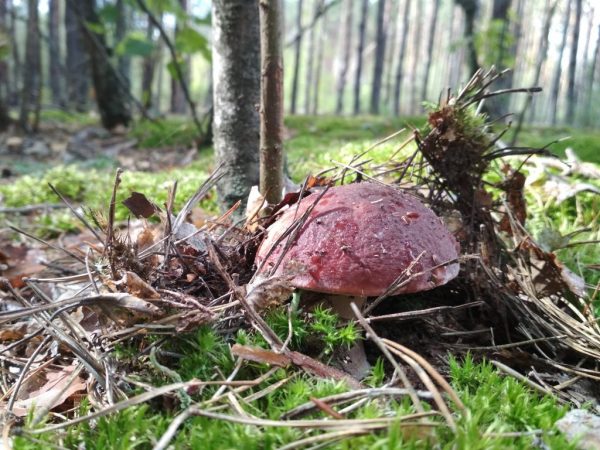Description of the false boletus
Not only edible mushrooms are found in the forest. They often have poisonous or unsuitable counterparts. One of these species is the false boletus (bitter boletus).

Description of the false boletus
Description
Boletus, also known as krasnogolovets or simply aspen, is a healthy and tasty edible mushroom. He is recognized by his bright yellow or orange cap, which resembles an autumn leaf in color. However, even such a unique mushroom has a double. It is important not to confuse them.
Boletus false boletus has characteristic distinctive features:
- It grows mainly in coniferous forests, where there are spruces and pines. Less commonly, it can form a symbiosis (mycorrhiza) with the roots of birch and oak. The edible mushroom never spawns near conifers.
- If a real boletus has a pattern in the form of jags (scales) on its leg, then its counterpart has a dense gray-brown mesh.
- False boletuses have a tubular hymenophore layer, like edible fruiting bodies. But they have it white (young mushroom), pink or dark pink (old) color. The edible boletus has a yellowish tubular substance.
- False boletus is rarely wormy.
- On cuts (breaks), the pulp turns pink. A real redhead turns blue and then turns black.
- The leg of bitter pot is darker (brownish, greenish) than that of edible fruit bodies.
- The shape of the cap of the false aspen tree is cushion-shaped, more convex in the center.
- To finally make sure that the boletus is false, the cut is slightly licked. Strong bitterness or lack thereof will indicate the true nature of the fruiting body.
Irina Selyutina (Biologist):
Toxins are present in the pulp of a gall mushroom, or bitter mushroom, which gives it a bitter taste. However, it is still not worth trying to "taste" bitterness. The compounds that give such a specific taste are easily absorbed even through the surface layer of the tongue and are carried through the blood. And this can cause further liver problems. Most often, bitter gourd is eaten only by accident, when, in the mass of lumps, it gets into conservation, where vinegar and other spices conceal its bitter taste. Symptoms may not appear immediately, but even after a few weeks or after a month, when the liver cells are already attacked. On the first day after eating the gall mushroom, quickly passing weakness and dizziness appear, which a person may not associate with eating mushrooms. But after a few weeks, the liver "strikes", which will disrupt the function of bile secretion. If the victim eats a large amount of gall fungus, cirrhosis of the liver may develop. Therefore, it is worth paying close attention to the collection of obboks and discarding doubtful specimens.
False boletus grows throughout the summer and autumn, until October. They are often found in clearings, rotten stumps, tree roots. They can grow both in groups and singly. They are similar to boletus (in shape), boletus and boletus (in cap color).
Cooking applications
False boletuses are inedible. They have a flavor that makes them unsuitable for food.Doubles in their taste resemble wormwood, their pulp is so bitter.
To avoid misunderstandings when preparing culinary dishes, the fruiting bodies are always carefully examined. If even one false boletus enters the pan, all of its contents will be spoiled.
The flesh of the mushroom is fleshy and pleasant in appearance, but the bitterness cannot be destroyed by any culinary treatment, although some mushroom pickers cook soup from bitterness and claim that drying neutralizes all the shortcomings of the fruit bodies.
Dried Double Soup

Bitter mushrooms are very bitter
To begin with, the bitters are dried. To do this, they are cut into small pieces.
Dried pieces of bittersweet are practically indistinguishable in appearance and smell from their noble counterparts. To test the taste, gnaw on the dry pulp. There should be only a slight hint of a little "peppercorn".
After that, the bitters are soaked in water. After a while, it is drained, and the swollen mushroom mass is thoroughly washed several times: this allows you to remove the remnants of bitterness. Fresh water is used to cook the soup. Bitters are immersed in it, the pan is put on the fire, and the mushroom broth is ready.
Cut potatoes, carrots, a little onion, alternately immerse in a saucepan, add salt. Cook until tender. The broth is transparent. A spoonful of sour cream is added to each serving. There is often a faint, almost inconspicuous, but not bitter aftertaste, similar to a slight "peppercorn".
The bitterness of a false mushroom, getting into the body, introduces some (in some cases, quite strong) dissonance in the work of the liver, so it is better to refrain from culinary experiments.
Application in medicine
Medicine has long begun to use false boletus to restore the liver after damage. They are used to make preparations with a choleretic effect.
In mustard, as in many other fruiting bodies of various types of edible mushrooms, there are elements with antiviral action, therefore, such a mushroom soup is useful for the period of colds.
Conclusion
The main commandment of a forest tourist: if you don't know a mushroom, don't take it! You should not risk your own health and life for the sake of momentary pleasure. One small poisonous double, accidentally ingested in food, can be fatal.



